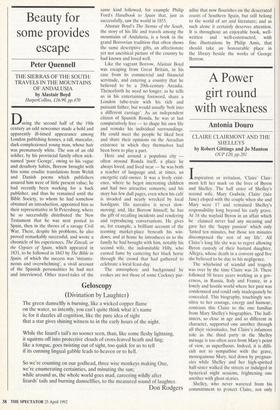Beauty for some provides escape
Peter Quennell
THE SIERRAS OF THE SOUTH: TRAVELS IN THE MOUNTAINS OF ANDALUSIA by Alastair Boyd HarperCollins, £16.99, pp.470 During the second half of the 19th century an odd newcomer made a bold and apparently ill-timed appearance among London publishing houses, a tall, muscular, dark-complexioned young man, whose hair was prematurely white. The son of an old soldier, by his provincial family often nick- named `poor George', owing to his vague and desultory habits, Borrow brought with him some erudite translations from Welsh and Danish poems which publishers assured him were of little present value; he had recently been working for a hack publisher, and thus he remained until the Bible Society, to whom he had somehow obtained an introduction, appointed him as their representative in St Petersburg, where he so successfully distributed the New Testament that he was next posted to Spain, then in the throes of a savage Civil War. There, despite his problems, he also proved remarkably successful, and wrote a chronicle of his experiences, The Zincali, or the Gypsies of Spain, which appeared in 1831, to be followed in 1843 by The Bible in Spain, of which the success was 'instanta- neous and overwhelming', a vivid account of the Spanish personalities he had met and interviewed. Other travel-tales of the
same kind followed, for example Philip Ford's Handbook to Spain that, just as successfully, saw the world in 1855.
Alastair Boyd's The Sierras of the South, the story of his life and travels among the mountains of Andalusia, is a book in the grand Borrovian tradition that often shows the same descriptive gifts, an affectionate yet not uncritical picture of the country he had known and loved well.
Like the vagrant Borrow, Alastair Boyd was escaping from Great Britain, in his case from its commercial and financial servitude, and entering a country that he believed to be a 20th-century Arcadia. Thenceforth he need no longer, as he tells us in his entertaining foreword, share a London tube-train with his rich and puissant father, but would usually 'bolt into a different carriage'. As an independent citizen of Spanish Ronda, he was at last comparatively free — to shape his own life and remake his individual surroundings. He could meet the people he liked best and share their opinions on the Arcadian existence in which they themselves had been born to play a part.
Here and around a populous city often around Ronda itself, a place he always loved, and lived near — he was both a teacher of language and, at times, an energetic café-owner. It was a lively exist- ence, where he begot interesting children and had two attractive consorts; and his story has few dull pages, even when his café is invaded and nearly wrecked by local hooligans. His narrative is never slow- moving; and, like Borrow himself, he has the gift of recalling incidents and rendering and reproducing conversations. He gives us, for example, a brilliant account of the teeming market-place beneath his win- dows; and at home he introduces us to the family he had brought with him, notably his second wife, the indomitable Hilly, who earned fame by cantering her black horse through the crowd that had gathered to celebrate a local feast-day.
The atmosphere and background he evokes are not those of some Cockney par-
adise that now flourishes on the desecrated coasts of Southern Spain, but still belong to the world of art and literature; and as such alone it certainly deserves attention. It is throughout an enjoyable book, well- written and well-constructed, with fine illustrations by Philip Amis, that should take an honourable place in the library beside the works of George Borrow.


























































 Previous page
Previous page